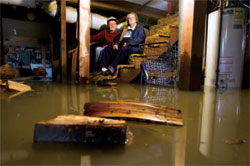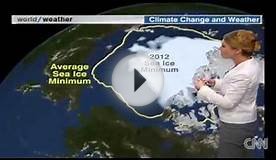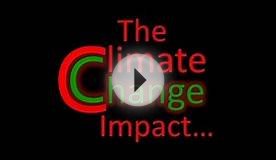Global climate change impacts in the world

Flooding creates serious health risks.
Heavy and prolonged precipitation can lead to a major flooding event and a dangerous cascade of health risks that can linger for months or even years.
In the days following a flood, drivers can drown as they attempt to navigate submerged roadways. Sewage systems can back up. Water sources may become contaminated. Even after the waters recede, the health risks continue as mold proliferates inside wet and damaged structures and flood victims struggle with the emotional toll of the disaster.
Flooding events are becoming more common in a warming world.
Rising temperatures have likely contributed to an increase in extreme rainfall events. As Earth's climate warms, the air is able to hold more water vapor, allowing for more intense downpours that can lead to flooding.
Measurements have shown that the number of heavy precipitation events has increased by more than 30 percent since 1900 in the United States—and the problem will likely grow worse in the coming years, leaving more and more Americans vulnerable to the immediate and lingering health impacts of flood events.
Report explores the health implications of flood events, now and in a warmer future.
 After the Storm: The Hidden Health Risks of Flooding in a Warming World combines a review of flooding health risks with a look at how climate change will likely increase the risks in the years ahead. It is the second report in a UCS series on Climate Change and Your Health.
After the Storm: The Hidden Health Risks of Flooding in a Warming World combines a review of flooding health risks with a look at how climate change will likely increase the risks in the years ahead. It is the second report in a UCS series on Climate Change and Your Health.
Report identifies the top five hidden health risks of extreme precipitation and flooding.
- Drowning while driving: Almost half of 2010 flood fatalities involved people who drowned while attempting to drive through floodwaters. Only 18 inches of water can lift a car or SUV; once buoyant, the water will easily push the vehicle sideway. Most vehicles then tend to roll over, trapping those inside.
- Waterborne diseases contaminating drinking water: Extreme precipitation and flooding can sometimes overwhelm drinking water infrastructure and wells, which reduces or prevents water purification. Over half of all waterborne disease outbreaks in the United States occur in the aftermath of heavy rain.
- Sewage back-up in plumbing or basements: Flooding can cause local sewage lines and septic tanks to overflow, sometimes resulting in sewage backing up into people's residences.
- Bacteria, sewage, and other contaminants in waterways: During flooding, untreated sewage, pesticides, and street contaminants (motor oil, dog excrement, etc.) can flow into local rivers, lakes, ponds, and even ocean beaches.
- Mold and dangerous indoor air quality: Water intrusion anywhere in a building can cause toxic mold to grow in ceilings, walls, or insulation.
Report highlights the growing flood risk from climate change and current development patterns.
The number of Americans living along coastlines and floodplains has grown twice as fast as the general population. Over half of all U.S. residents now live in coastal counties that could be susceptible to flooding and an estimated 10 million households are located within floodplains.
The movement of people into coastal areas and floodplains also affects the terrain, which in turn affects vulnerability. As we cut trees and clear lands for buildings and roads, we reduce the land's natural defenses—and heighten our exposure—to flooding.

